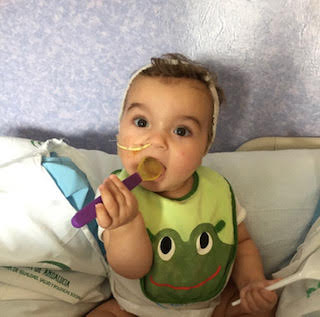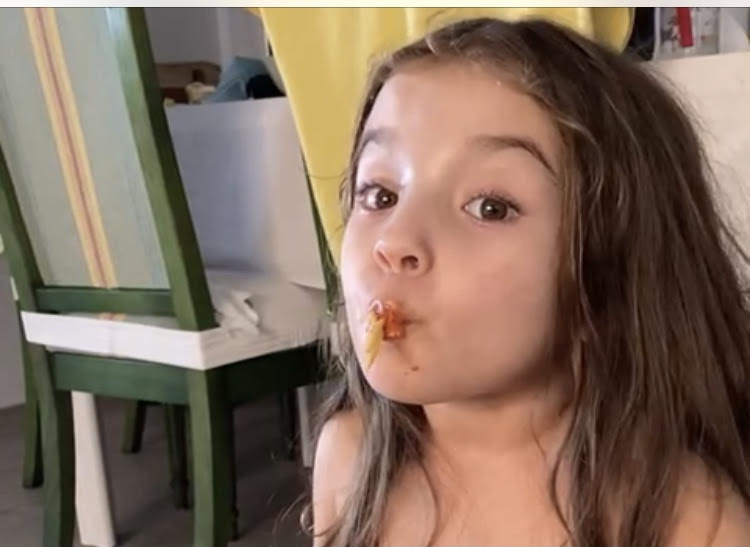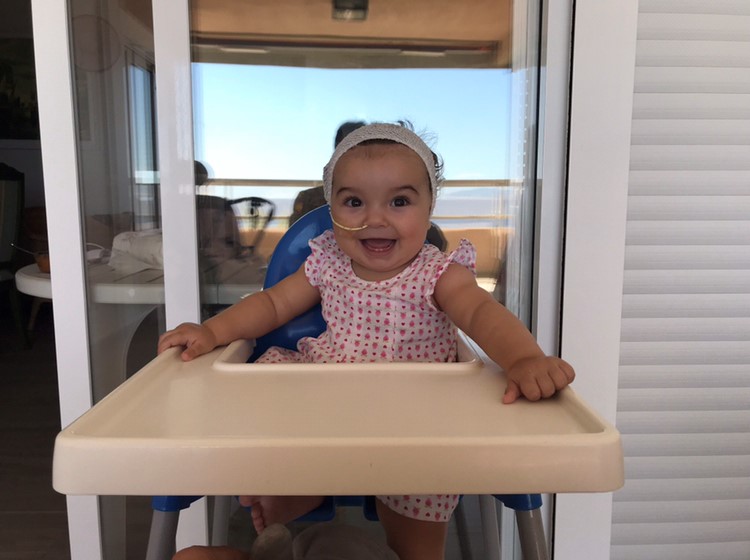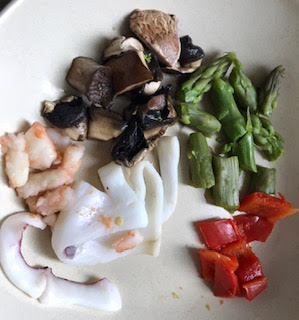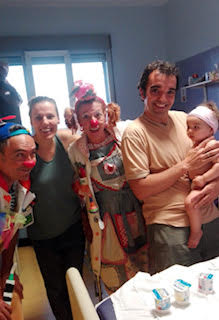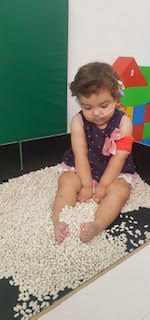This post is also available in:
 Español (Spanish)
Español (Spanish)  Italiano (Italian)
Italiano (Italian)
Hello Warriors! Long time! Since I’m a little better and have more “social life” the blog is a little abandoned, but I’m sure you understand… and we see each other frequently in social networks anyway 😊
Some time ago I told you how intense and risky my life was before I met Dr. Derks and before I went to The Netherlands to follow an experimental treatment for GSD type 1b
You may remember that apart from severe hypoglycemia, serious infections or several emergencies, one of the things that more work, perseverance, energy , tenacity, patience and good sense of humor required was the need to teach me how to eat by mouth, to take solid food.
This was tremendously important, to be nourished like any other child, to have a healthier diet, to leave the nasogastric tube one day (at least during the day), to receive vitamins, proteins, nutrients, fiber, in a more natural way.
The thing is that learning to eat when you are living with GSD is not that easy. On the one hand, having a nasogastric tube is not at all pleasant and it bothers a bit when you are trying to learn. On the other hand, even those little ones who do not have the NG tube and went for a G-tube also have challenges. Why? Mainly because our stomach is always full a we have a permanent feeling of satiety.
As you may remember, we have to take cornstarch (CS) dissolved into water several times a day. It becomes a thick lump in the stomach and is digested little by little… and when it is almost finished… Boom! … another meal and another CS. Being a slow absorption carbohydrate, cornstarch, gives us energy for about three hours and it helps us make longer fasting period and have better quality of life … but it does not help at all if you want to feel like eating.
Now I am eating like a champion, I enjoy the food, sometimes I even say I ‘m hungry!!!! (then my parents shed a tear of joy..)
Getting there has not been easy. We have fought every spoon, every food, every meal, everyday, every week, month and year. It has been an enormous effort, specially considering the severity of the disease (not being able to sleep well at night, the stress of hypoglycemia or emergencies …) and in the midst of a pandemic. Now we are super happy with the good results. It has all been worth it! 😊
We are infinitely grateful to many people: to Florentine, the super professional we met at the University Medical Center in Groningen (UMCG) in The Netherlands, part of Wonderful Dr. Derks multidisciplinary team, who made us have real hope for the first time in this regard, and to all our relatives, friends, caregivers, speech therapists or healthcare professionals who have fed me (or tried to), who have given us useful advice, or who have done a thousand crazy things in front of me to give me courage and strength. It has really been a marathon that we have run as a team.
We take this opportunity to leave here some recommendations for families who are now going through this period. For all of them, we send a lot of strength and positive vibes! Don’t throw in the towel. You will get there, spoon by spoon, day by day, one thing at a time.
Remember that we are not speech therapists, or health professionals. We suggest you consult with your medical team at the hospital. However, as many of you have asked us to tell our experience, we believe that it is worth sharing our adventures, as so many of you have done with us before. Here we go:
– Make it a FORMAL moment … and also a PLEASANT and FUNNY one. This is not incompatible!
It is very important that the little one understands that it is time to have a meal and that this is what he/she has to do. If you had seen me in the beginning … Mamma mia! I would try to eat for 5 minutes and then I would run away and start playing… and my parents would run after me, spoon in hand…
You have to avoid that and the ideal thing is to have a highchair for babies (I could escape even from those, but it was a bit more difficult… 🙂 ).
You also have to be assertive and convincing, in a pleasant way, but without leaving room for hesitation, because the baby has to eat and that is not negotiable. You have to insist and be constant, but never, never, never, force the child or lose patience, or let him/her see your frustration when food is rejected. It is necessary to avoid at all costs that the moment of eating is identified as a forced or unpleasant moment.
Formality and assertiveness can go together with fun. You can chat, sing, bring a doll or a book or have someone else accompany the moment ” cheering” … etc. Once in a while you can also be very creative and present your food as if it were, for example, the face of a clown (two cucumber slices as eyes, a pepper as a nose, a mouth made of chicken … etc.)
I especially remember a very magical moment: in the middle of the pandemic, in Spain, hundreds of people came out to their balconies at 8:00 p.m. to applaud the healthcare professionals. My parents planned to give me dinner so that I would finish at 8:00 pm. And so it happened, I finished dinner and hundreds of people began to applaud (me) … my parents more than anyone … so I gave them my usual smile and my eyebrow lift … and I spent several weeks highly motivated by dinner.
– If possible, let them eat with other children and have other people help you. Avoid screens.
Eating with other children always made me eat better. I don’t know why, maybe because of imitation, because I felt part of a group, because somehow it encouraged my appetite … who knows. I remember that during our time in the Ronald McDonald House in Malaga where there were other children and families who had to live near the hospital, it helped me to see them eat and everyone there encouraged me a lot. Since I started going to kindergarten I have also made a lot of progress, I have learned to eat by myself. This summer I have spent a few weeks with my cousins who are “very good eaters” and I have made even more progress. Sometimes someone feeds me because apart from eating exact weighted amounts of food we must also control the timing in which I eat them… but soon I will manage to eat everything on time by myself.
I also remember that when someone “new” tried to feed me, I ate better. I don’t know if it was because of the novelty, because they did it differently or because they look fresher, but it was like I was more predisposed.
I admit that a few times I have eaten watching a video on the phone, especially on days when there was absolutely no way to make me eat. But screens have their risks: every time I watched a video at lunch, I also asked for a video that day at dinner, and the same the next day. I began to link food with videos and knowing that “screens” are not good for children, this had to be controlled. Luckily, I am very curious and I am entertained with almost anything so it was easy to disconnect from them.
– Try different foods, flavors, textures, colors.
It is important to train our taste and get used to eating a big variety of things. It is good to identify what we like the most and what attracts us, but keep offering us a bit of everything, and if we reject something, keep trying (insist, do not force) any other time. When the little one accept a new food, give it to him/her in several occassions any other time so that the acceptance is consolidated.
– Use small plates or containers, adjusted to the amount of food the little one should eat:
We all love feeling like we have achieved something, that we have succeded. If we see that we have left the plate empty, we feel better, and we are more eager to get it next time. We do not want large plates with more food than we need so that by the end of the meal we see leftovers on the plate…
– Have a system, consolidate progress, increase quantity and improve timing gradually:
For instance, choose 5 different foods, a piece of: boiled egg, macaroni, fish, avocado and a chickpea.
Start the first day by giving a single piece of one of these foods and see how the little one reacts. If you give him a chickpea and he spits it out, do not worry, he/she should not see you frustrated, remove the chickpea discreetly and write down in a registry that he has not eaten it. You can try again any other time till your succeed and, in the meantime, you can try other things.
If, on the other hand, he/she eats chickpeas well, congratulate him/her, write it down in the registry, and on the next try, give him two chickpeas (one after the other) instead of just one.
Same with all foods, until the amount increases little by little. When the little ones eat considerable quantities, if it takes them a long time to eat (half an hour, an hour), you will have to try to shorten the timing step by step. Then the little one should start eating alone … and well, as he/she grows up, everything will get easier.
– Do not be afraid to give them pieces of food appropriate to their capacity:
For a while, I was given very small pieces of food thinking that this could help me to learn and to avoid possible choking. However, when the pieces were too small, they got lost in my mouth, I was not aware of what I was eating, it was not easy for me to move the food with my tongue or to chew it.
I remember when Florentine in The Netherlands, for the first time, took a sizeable piece of food and put it in my mouth. I will not forget the *surprise face” of my parents. Even I was surprised and raised my eyebrows. I soon realized that I could finally feel the food well and that I could actually control it. When I was two years old, I managed to eat my first piece of lasagna for the first time … It was probably just two centimeters of food, but what a celebration we did… 😊
– Train:
Like any other muscle of the body, those involved in eating must be exercised.
I remember when I was about 9 months old and we started trying to introduce food by mouth. A few tablespoons of baby food were quite an achievement and many times they had to put the baby food through the NG tube … (at that time they only gave us very small enteral nutrition syringes … my parents still have calluses on their fingers … 😊 )
I have gone through 4 speech therapists and they all recommended a lot of practice and training. Some of them used silicone devices for the mouth muscles (I remember, in particular, one that was shaped like an octopus leg … haha … big tentacles!! …), they gently massaged my cheeks, my jaw, the part between the chin and the walnut, they caressed my lips with food, or let me manipulate or smell different foods.
– Delay a bit the intake of cornstarch:
As mentioned before, cornstarch makes us always feel full. If you have the opportunity and you feel safe to do so, in coordination with your medical team, you could place lunch and dinner as far away as possible from the previous intake of cornstarch. For example, if the little one eats cornstarch at 10:00 and he has to eat again at 12:45 or 13:00, instead of giving him/her the food + CS again, you can give him/her a small carbohydrate snack that keep him/her stable until 13:30 or 13:45 … and there start the meal.
This is not very orthodox and requires more work, attention and control , but it has helped us until we have managed to improve. We leave it up to you and your medical team to see if it can be useful.
Anyway, we hope that you find useful some of these tips. The final recommendation is that you keep trying, without giving up, and with the conviction that you will succeed.
Again, many thanks to all those of you who have helped us along the way.
Millions of NinAhugs
